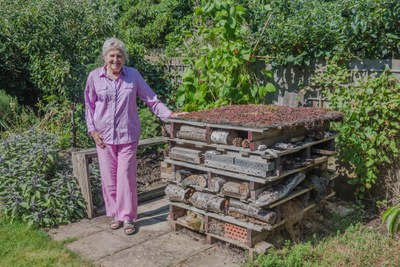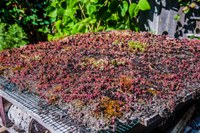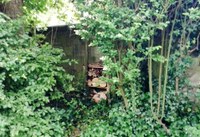It’s A Bug’s Life
Can ‘bug hotels’ help God’s creation to flourish?
Church House is boasting some brand new residents, thanks to a luxury hotel development: a bug hotel!
The strange new development against the Crane Street wall in the garden was suggested by an Eco Church survey as something that would be good to provide. It might sound like a gimmick, but it’s anything but. Insects are the backbone of a healthy global ecosystem – but their numbers are facing catastrophic decline.
This is part of the Diocese’s commitment to working more sustainably, and also to achieving an Eco Diocese award. So there have been cycle racks installed, more ecologically friendly loo rolls, biodegradable cups for the water coolers, and a new system for printers which should cut down on waste paper.
But individuals can also do install a bug hotel at their own home if they have outdoor space to do so, and help work against the declining number of insects.
 Among those who have done so are Canon Bruce and Margaret Duncan in Harnham.
Among those who have done so are Canon Bruce and Margaret Duncan in Harnham.
“It was very cheap”, says Margaret, “the only cost was the sedum roof which cost about a tenner. Apart from that, we used old sacking, bundles of straw, old shoes, shells, fir cones, and we drilled a few holes in logs.
“A local firm gave us some old palettes for the superstructure.
“The whole garden is planned with two ideas in mind: easy care and habitability for wildlife. When we first saw a bug hotel when visiting Hengistbury Head we knew it would work for us.
“Since we put it in, we’ve seen interesting wildlife attracted by it; especially on the south side, it’s very popular with various solitary bee species like masonry bees. In the snow earlier this year, we saw footprints, so we think there’s a hedgehog and also field mice. We also saw insects overwinter in it like lacewing, ladrybirds and butterflies.
 “Part of our philosophy as Christians is to live with all of nature and God’s creation in the most loving way. Perhaps it also owes something to the Native American idea of only taking from nature what you need and fostering the rest.
“Part of our philosophy as Christians is to live with all of nature and God’s creation in the most loving way. Perhaps it also owes something to the Native American idea of only taking from nature what you need and fostering the rest.
“We’d also say our pond is very important, and we wish more people would have them. We see frogs, baby newts, water skaters, dragonflies and damselflies in it.”
The Diocese’s Social Justice Programme Manager, Colin Brady, said, “We are hoping to achieve Eco Diocese status fairly soon. To do this we need to get ten per cent of our churches registered with five per cent having achieved an award under the scheme.
 “We currently have 46 churches registered, plus the Cathedral and Hilfield Friary, and fifteen churches have awards. So we are getting very close, and we might even end up being the first Eco Diocese .
“We currently have 46 churches registered, plus the Cathedral and Hilfield Friary, and fifteen churches have awards. So we are getting very close, and we might even end up being the first Eco Diocese .
“Please do get your church to join in the scheme!
“Together with the Living Churchyards that are such a distinct and vital part of the Diocese’s witness, we are making a huge contribution to helping the insects and crawling creatures that are so vital to making our planet fit for human life, and which show the glory of God.”
Learn how to make a Bug Hotel on the RSPB website or with the help of this YouTube video.
Document Actions


